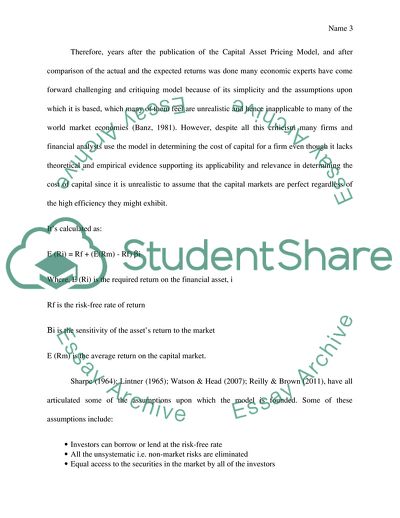Cite this document
(The Capital asset pricing model (CAPM) is a very useful model and it Essay - 6, n.d.)
The Capital asset pricing model (CAPM) is a very useful model and it Essay - 6. https://studentshare.org/finance-accounting/1849390-the-capital-asset-pricing-model-capm-is-a-very-useful-model-and-it-is-used-widely-in-the-industry-even-though-it-is-based-on-very-strong-assumptions-discuss-in-the-light-of-recent-developments-in-the-area
The Capital asset pricing model (CAPM) is a very useful model and it Essay - 6. https://studentshare.org/finance-accounting/1849390-the-capital-asset-pricing-model-capm-is-a-very-useful-model-and-it-is-used-widely-in-the-industry-even-though-it-is-based-on-very-strong-assumptions-discuss-in-the-light-of-recent-developments-in-the-area
(The Capital Asset Pricing Model (CAPM) Is a Very Useful Model and It Essay - 6)
The Capital Asset Pricing Model (CAPM) Is a Very Useful Model and It Essay - 6. https://studentshare.org/finance-accounting/1849390-the-capital-asset-pricing-model-capm-is-a-very-useful-model-and-it-is-used-widely-in-the-industry-even-though-it-is-based-on-very-strong-assumptions-discuss-in-the-light-of-recent-developments-in-the-area.
The Capital Asset Pricing Model (CAPM) Is a Very Useful Model and It Essay - 6. https://studentshare.org/finance-accounting/1849390-the-capital-asset-pricing-model-capm-is-a-very-useful-model-and-it-is-used-widely-in-the-industry-even-though-it-is-based-on-very-strong-assumptions-discuss-in-the-light-of-recent-developments-in-the-area.
“The Capital Asset Pricing Model (CAPM) Is a Very Useful Model and It Essay - 6”. https://studentshare.org/finance-accounting/1849390-the-capital-asset-pricing-model-capm-is-a-very-useful-model-and-it-is-used-widely-in-the-industry-even-though-it-is-based-on-very-strong-assumptions-discuss-in-the-light-of-recent-developments-in-the-area.


